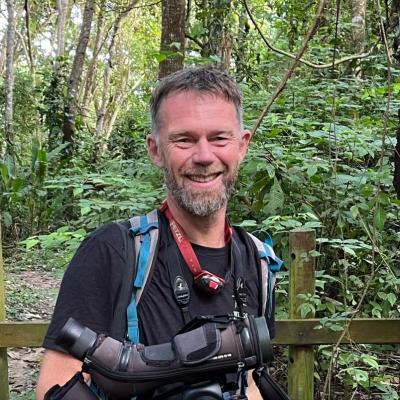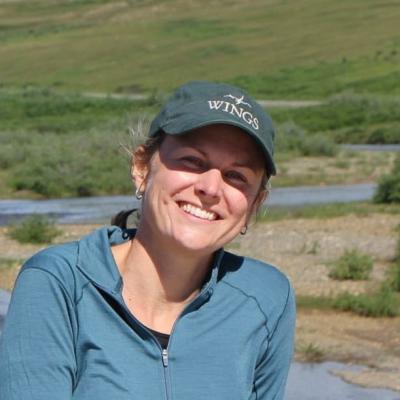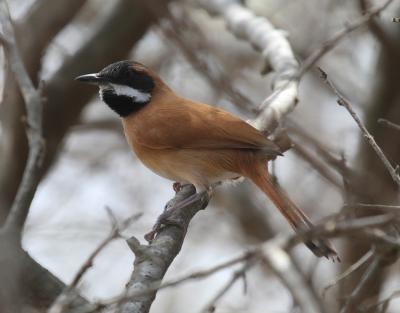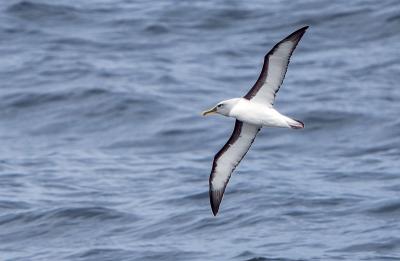Colombia: The Chocó
An introduction to the megadiverse Colombian Chocó
-
Jan 16-27, 2026
Fabrice Schmitt
-
Feb 2028
Fabrice Schmitt
2026
Single Room Supplement $650
2028
Tour Price to be Determined
2026
Single Room Supplement $650
2028
Tour Price to be Determined
The Chocó area of Western Colombia and Ecuador encompasses the Pacific slope of both the Colombian West Andes and the Central Andes. Most of the habitat is characterized by wet forest, and with up to 630 inches of rain per year in places, mostly April-June and October-December, it is perhaps the wettest place on earth.
It is as well one of the world’s richest lowland biotas, with exceptional endemism in a wide range of taxa including plants, reptiles, amphibians, butterflies and, of course, birds. For example, 10% of 80-90,000 plant species recorded in the Neotropics have been found in the Chocó, and 25% of these are endemic to this narrow strip of land. The Chocó also supports the largest number of restricted-range bird species of any area in the Americas, and more than 60 of these are endemic.
We’ll bird at various elevations on the western slope of the Colombian Cordillera Occidental, from the brilliant white sand beaches near Bahía Solano to the montane tropical forest of the Las Tángaras ProAves Reserve and, at about 9000 feet, the temperate forest at La Eme. We expect to find spectacular birds at every elevation.
We’ll visit several hummingbird feeding stations (many of them in our lodge gardens), with great views of as many as 30 of the 40 species possible during the tour. In addition to the Chocó area, we’ll explore the dry Cauca valley looking for species restricted to that habitat, and the temperate forests near the colonial town of Jardín, looking for the vulnerable Yellow-eared Parrot and visiting a feeding station which attracts both Chestnut-naped and Chami Antpittas!
This tour can be taken in conjunction with the popular Colombia: The Santa Marta Mountains tour.
Day 1: The tour begins at 6 pm this evening in Medellín. Night in Medellín.
Day 2: We’ll fly to Bahía Solano on the Pacific coast, hopefully getting great looks at the vast and pristine tropical forest of the Western Cordillera, a habitat we’ll be exploring later in the trip. Once in Bahía Solano, we’ll transfer to the little coastal hamlet of El Valle and our comfortable hotel situated just a few yards from a wonderful white sand beach. During our drive from the airport to El Valle, we have a good chance of finding our first Chestnut-headed Oropendola, Choco Toucan, Black-cheeked Woodpecker, Flame-rumped Tanager, Purple-throated Fruitcrow and Variable Seedeater. In the evening, we'll bird the El Valle surroundings, looking for Yellow-throated Toucan, Saffron-headed Parrot, Red-lored Amazon and Pacific Antwren. Night in El Valle.
Day 3: We’ll spend the morning along a trail heading from El Valle toward Utria National Park. Birding secondary growth forest along this trail is always exciting, and we have good chance of finding Dusky-faced Tanager, Spotted and Chestnut-backed Antbirds, Dusky Pigeon, Spot-crowned Barbet, Checker-throated Stipplethroat, Bay Wren, Gray-headed Chachalaca, and the pompous Pied Puffbird. The mixed-species flocks here usually include Golden-hooded, Plain-colored and Rufous-winged Tanagers, Red-legged Honeycreeper, Blue and Scarlet-thighed Dacnis and Tawny-crested Tanager. In the late afternoon, after a welcome break during the warmest hours of the day, we’ll bird in the El Valle area or perhaps back on the Utria trail...or you can stay at the hotel and enjoy the lovely beach. Night in El Valle.
Day 4: After a pre-dawn breakfast, we’ll take a boat to Utria, one of the most beautiful Colombian National Parks. Here, a fabulous and pristine forest covers the coastal hills and dives into the tropical waters with a line of white sand beaches separating the green forest from the emerald water. Even though Utria NP doesn’t offer an extensive trail system, we have a good chance of finding the elusive Brown Wood-Rail, Blue-chested Hummingbird, the very localized Humboldt’s Sapphire, White-tailed Trogon, the beautiful Cinnamon Woodpecker or even the fancy Black-tipped Cotinga. There is also a slim chance of finding the unique Broad-billed Sapayoa, a species recently placed in its own family, the Sapayoidae, closely related to the Old World Broadbills.
As bird activity slows dramatically as the day warms, there will be time in the late morning to snorkel in the magical turquoise waters where the fish species diversity exceeds that of the birds! After returning to El Valle and an afternoon break, we’ll look for more birds including White-necked and White-whiskered Puffbird, Collared Aracari, Spot-crowned Antvireo, Tawny-faced Gnatwren, and the very cute Orange-billed Sparrow. Night in El Valle.
Day 5: We’ll have time for early morning birding before flying back to Medellín. Depending on when we arrive, we may visit La Romera, a fine forested area of the Central Cordillera, or just relax in the garden of our excellent hotel. Night in Medellín.
Day 6: We’ll spend the morning at La Romera where we have a good chance of finding the noisy Colombian endemic Red-bellied Grackle as well as other species of the Central Cordillera such as Stile’s Tapaculo, Colombian Chachalaca, Greenish Puffleg, Bar-crested Antshrike and Pale-naped Brushfinch.
Later we’ll drive towards the dry Cauca valley, a major biogeographical barrier separating the Western Cordillera from the central Andes. A number of endemics and specialties including Grayish Piculet, Apical Flycatcher, Antioquia Wren (a species only described in 2012), and Colombian (Speckle-breasted) Wren are present and we hope to encounter them during our stops along the Cauca. After birding these two very different locations, we’ll re-enter the Chocó zone at mid-elevation in the Western Cordillera. Night Las Tángaras Lodge.
Day 7-8: We’ll have two full days exploring the Las Tángaras ProAves Reserve and its surroundings. Along a wide track through wonderful montane forest, we’ll search for mixed flocks that can be thrillingly large and often full of specialties such as Buffy Tuftedcheek, Fulvous-dotted Treerunner, Glistening-green and Purplish-mantled Tanagers, Toucan Barbet and Yellow-collared Chlorophonia. We hope to find a key endemic, the Black-and-gold Tanager, usually quite common at this site. A trail up into the ProAves reserve gives us access to the understory where we’ll seek Yellow-breasted Antpitta, Choco Vireo, Nariño Tapaculo, Choco Brushfinch, Bronze-olive Pygmy-Tyrant, and with great good luck the elegant Black Solitaire. We’ll have time as well at the reserve’s hummingbird feeders where Violet-tailed Sylph, Velvet-purple Coronet, Brown Inca, Purple-bibbed Whitetip and Rufous-gaped Hillstar are all possible. Nights at Las Tángaras Lodge.
Day 9: We’ll visit the remote La Eme ridge looking particularly for Munchique Wood-Wren, Tanager Finch, Black-billed Mountain-Toucan and Chestnut-crested Cotinga. This spectacular temperate forest often holds mixed-species flocks and we expect to spend much of the morning here. Botany enthusiasts will be impressed by the orchid richness as dozens of species can be found along the roadside. After lunch at Las Tángaras, we’ll continue towards the picturesque colonial town of Jardín, arriving in time to visit an Andean Cock-of-the-rock lek situated at the edge of the town. The stunning males are often remarkably tame and usually offer good photographic opportunities along with fantastic views. Night Jardín.
Day 10: We’ll need an early start for our dawn visit to the Yellow-eared Parrot roosting area. These endangered macaw-like parrots are now only found in Colombia, having been recently extirpated in other nearby countries, and we’ll look for them in one of their few remaining strongholds. After our early morning, we’ll have breakfast at Doña Luisa’s place, enjoying good views of Long-tailed Sylph and Buff-tailed Coronet coming to her feeders, and then visit her famous antpitta feeding station where Chestnut-naped and Chami Antpitta sometimes take worms from visitors’ hands!
We’ll spend the rest of the day birding back down the road to Jardín, hoping to find Black-collared Jay, Montane Woodcreeper, Gray-browed Brushfinch, Golden-headed Quetzal, and large mixed-species flocks usually including Golden-fronted Redstart, Pearled Treerunner, Lacrimose Mountain-tanager, Gray-hooded Bush-Tanager, Blue-and-black Tanager. Boreal migrants such as Black-and-white, Blackburnian and Canada Warblers are often present along with many more temperate forest birds. We’ll return to town in the afternoon. Night in Jardín.
Day 11: After morning birding and a visit to the charming town of Jardín, where we can find an excellent cup of coffee on the beautiful main square, we’ll start our drive back to Medellín, arriving in the mid-afternoon. We’ll conclude our tour with a farewell dinner in Medellín. Night Medellín.
Day 12: The tour concludes this morning with transfers to the Medellín airport.
Note: The information presented here is an abbreviated version of our formal General Information for Tours to Colombia. Its purpose is solely to give readers a sense of what might be involved if they took this tour. Although we do our best to make sure what follows here is completely accurate, it should not be used as a replacement for the formal document which will be sent to all tour registrants, and whose contents supersedes any information contained here.
ENTERING COLOMBIA: US citizens must present a passport valid at the time of entry and with at least one blank page for an entry stamp. No visa is required for US citizens visiting Colombia for 60 days or less. Visitors from other countries may need a visa; please contact your nearest Colombian embassy or consulate for further information.
COUNTRY INFORMATION: You can review the U.S. Department of State Country Specific Travel Information here: https://travel.state.gov/content/travel.html and the CIA World Factbook here: https://www.cia.gov/the-world-factbook/. Review foreign travel advice from the UK government here: https://www.gov.uk/foreign-travel-advice and travel advice and advisories from the Government of Canada here: https://travel.gc.ca/travelling/advisories.
Safety: After years of instability, Colombia is once again becoming a safe destination for sensible international travelers. The Colombian government has made significant progress in strengthening its democratic institutions, promoting respect for human rights and the rule of law, intensifying counter-narcotics efforts, fostering socioeconomic development, addressing immediate humanitarian needs, and ending the threats to democracy posed by narcotics trafficking and terrorism. Security has improved massively and violence has decreased markedly in most areas, and there is no significant terrorist threat in the areas we will visit. However petty crimes such as pickpocketing are common in major cities including airports, so be careful.
PACE OF TOUR: The aim of this trip is to enjoy Colombia’s incredible biodiversity, at the most relaxed pace possible. Of course, as any birding tour, expect early starts and sometimes long drives, but we will also enjoy quiet and prolonged time at feeders and most of the walk are easy!
The pace of our tour will be set to the rhythm of the tropical birds, which means we’ll be out in the field as soon as the sun rises. Most of our days will begin between 5:00 and 6:00 a.m., however there will be some mornings when we start at 04:30 so that we reach areas in time for a field breakfast and dawn birding. Some breakfasts will be taken in the field, others will be eaten at our hotels and lodges. On some days we will take a picnic lunch in the field and on others we will stop at roadside restaurants.
Participants should be able to walk at a slow to moderate pace for four or five hours at a time; we may walk in the sun on some roads, though most of our trails will be in the shade. Most of our walking is along roads, and there’s generally no major change in altitude. When we’re in the mountains, we always try to walk downhill. Our vehicle will almost always follow the group at a distance, and so it’s possible to return to the vehicle for a rest if necessary.
The toughest trail will be at Las Tángaras reserve, where we may walk 4km along a narrow up-and-down trail to reach some interesting forest (people who don’t want to hike this trail can stay at the comfortable lodge).
Sturdy shoes or boots are necessary and a walking stick may be helpful at times. While we plan this trip for the dry season, strong rains can occur anytime, especially on the coast where we expect muddy trails, so gum boots or neos are recommended. (If you don't want to carry heavy boots to Colombia, you can purchase a pair once in Bahia Solano for about $15, although we can't guarantee the availability of your exact size (sizes above 11 are rare.)
Be aware that on most days you will not be able to return to the lodge on your own should you become tired. On some days however, it will be possible to stay behind and bird the lodge grounds; there is time for a siesta on those days.
Because the forests of the Colombian Andes are highly fragmented and only a few scattered sites remain accessible, there will be a few long drives between birding localities. We usually drive 3-4 hours between two birding sites, but the drive could be as long as 6 hours from Medellin to Las Tangaras. Traffic in Colombia can also be very hazardous, and at any moment traffic jams, roadworks or demonstrations can delay our movements. We will spend most of our time in mountain areas, and people can be subject to motion sickness on these mountain roads. The long drives will be broken up by restroom breaks and lunch stops.
The group will typically return to our lodgings around 5:00 p.m., with dinner generally starting around 6:30. On most days there will be a break of at least one hour between getting back and meeting up for dinner. The leader will call a list of the birds recorded during the day either just before or just after dinner.
HEALTH: The Centers for Disease Control and Prevention (CDC) recommends that all travelers be up to date on routine vaccinations. These include measles-mumps-rubella (MMR) vaccine, diphtheria-tetanus-pertussis vaccine, varicella (chickenpox) vaccine, polio vaccine, and your yearly flu shot.
They further recommend that most travelers have protection against Hepatitis A and Typhoid. Please contact your doctor well in advance of your tour’s departure as some medications must be initiated weeks before the period of possible exposure.
The most current information about travelers’ health recommendations for Colombia can be found on the CDC’s Travel Health website here: https://wwwnc.cdc.gov/travel/destinations/list
Malaria: A very small part of the tour is conducted in areas where there is a low risk of malaria; the remainder is at altitudes where it does not occur. Your tour guides will not be taking anti-malarial drugs. Please consult your physician.
Dengue Fever and Chikungunya: Dengue Fever and Chikungunya virus also occur in parts of Colombia and seems to be becoming more common in many parts of South America. There is no inoculation available for dengue, so no protection can be made in advance of travel. This disease is transmitted by diurnal mosquitoes mostly in heavily populated areas. It is important therefore cover up and use repellent wherever mosquitoes might be encountered.
Yellow Fever: At the time of writing, no proof of vaccination is required to enter Colombia unless traveling from a country with a risk of YFV transmission; however the CDC recommends a Yellow Fever vaccination for visitors to certain areas where there is a risk of transmission at altitudes below 2300m.
Note that the CDC and World Health Organization are said to be on the verge of announcing that a single Yellow Fever vaccination sometime during your life is enough to confer immunity. Please check the CDC’s Travel Health website and consult your physician.
Altitude: Altitude is not a major concern on this tour. The highest point we will be birding is La Eme ProAves reserve at 9,800 feet elevation (3,000 m). We will stay at that elevation just one or two hours before dropping down to lower elevation. So far, no clients have ever had a serious problem with altitude sickness at that location.
Smoking: Smoking or vaping is prohibited in the vehicles or when the group is gathered for meals, checklists, etc. If you are sharing a room with a nonsmoker, please do not smoke in the room. If you smoke in the field, do so well away and downwind from the group. If any location where the group is gathered has a stricter policy than the WINGS policy, that stricter policy will prevail.
Miscellaneous: Bottled water is readily available throughout the areas visited. Drinking water is provided at reserves, in the van when we are on the road, and with meals.
There are few issues with insects on this tour. Chiggers are present off the roads in Santa Marta, but are not a real problem. There are a few mosquitoes in some areas. Bring a good insect repellent for mosquitoes and other insects that we will occasionally encounter.
CLIMATE: The Chocó is one of the wettest places on Earth, so you need to be prepared for some tropical rains. Along the coast, it will be hot (expect 85-90°F) and very humid. In the Cauca valley, it will be as hot (80-90°F) but dry. Our lodges at Las Tangaras, Montezuma and El Queremal are at middle elevation (all between 4,000 and 5,000 feet elevation), with pleasant daytime temperature and cooler nights. Temperatures can be cold when we will be birding at higher elevation, like at La Eme at 9,800 feet elevation, – a fleece, scarf and gloves are recommended here and might also be useful at other high elevation sites such as the upper part of the road above Jardin.
ACCOMMODATION: All of our lodges have electricity and all but the one on the coast have hot water. In Medellin, we stay in a comfortable modern hotel. In El Valle and Jardin we use comfortable countryside hotels. The Las Tangaras lodge, administrated by the Colombian NGO Pro Aves, has simple rooms wiht hot water, wifi in the dining area, and wonderful hummingbird and tanager feeders! Outside of the cities, many of our accommodations are in very birdy settings, and some exciting birding can be had right from the balconies. Some of the hotels we visit on this tour have swimming pools, so guests may wish to come suitably prepared.
FOOD: Colombian cuisine is very diverse and varies depending on the different regions of Colombia. In some areas you will find specialties like roasted ants or guinea pigs while in other areas Colombians wouldn’t even touch those dishes.
Colombia is not a paradise for vegetarians as the Colombian diet includes a lot of meat. In the coastal areas you will find a good variety of fish, and seafood often prepared with a sauce made out of coconut milk. The offer of fresh fruit is overwhelming and many of the varieties you have probably never heard of before.
In general breakfast is quite important in Colombia and consists of fruit juice, coffee or hot chocolate, fruit, eggs and bread.
WINGS tours are all-inclusive and no refunds can be issued for any tour meals participants choose to skip.
Drinks: Bottled water or a soft drink or a beer is provided at lunch and dinner, as is coffee or tea. Bottled water is provided for day us in the vehicle.
Food Allergies/Requirements: We cannot guarantee that all food allergies can be accommodated at every destination. Participants with significant food allergies or special dietary requirements should bring appropriate foods with them for those times when their needs cannot be met. Announced meal times are always approximate depending on how the day unfolds. Participants who need to eat according to a fixed schedule should bring supplemental food. Please contact the WINGS office if you have any questions.
TRANSPORTATION: Travel will mostly be by minibus, with 4wd jeeps used in a few localities such as in the Las Tangaras area and above Jardin. In some areas, van travel will alternate with jeep rides to the higher elevations.
Note that jeep rides can be rough and cramped for short distances. Participants must be willing to take their turn to ride in any seat in tour vehicles.
We will fly from Medellin to Bahia Solano, and return, by small plane allowing only 10 kg per person for luggage. As you don’t need all your heavy clothes to bird the warm lowlands, you will be able to leave some of your equipment at the hotel in Medellin where we will stay on our way back from the coast. It might be very useful to bring a light bag with you to split your equipment, between what you take with you to Bahia Solano and what you leave in Medellin. It is possible to bring more than 10 kg of equipment on the Bahia Solano flight, but you will be responsible for covering your own excess baggage charges.
Maximum group size is eight participants with one leader.
































